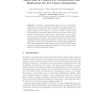Free Online Productivity Tools
i2Speak
i2Symbol
i2OCR
iTex2Img
iWeb2Print
iWeb2Shot
i2Type
iPdf2Split
iPdf2Merge
i2Bopomofo
i2Arabic
i2Style
i2Image
i2PDF
iLatex2Rtf
Sci2ools
ANTSW
2004
Springer
2004
Springer
Search Bias in Constructive Metaheuristics and Implications for Ant Colony Optimisation
Constructive metaheuristics explore a tree of constructive decisions, the topology of which is determined by the way solutions are represented and constructed. Some solution representations allow particular solutions to be reached on a greater number of paths in this construction tree than other solutions, which can introduce a bias to the search. A bias can also be introduced by the topology of the construction tree. This is particularly the case in problems where certain solution representations are infeasible. This paper presents an examination of the mechanisms that determine the topologies of construction trees and the implications for ant colony optimisation. The results provide insights into why certain assignment orders perform better in problems such as the quadratic and generalised assignment problems, in terms of both solution quality and avoiding infeasible solutions.
| Added | 30 Jun 2010 |
| Updated | 30 Jun 2010 |
| Type | Conference |
| Year | 2004 |
| Where | ANTSW |
| Authors | James Montgomery, Marcus Randall, Tim Hendtlass |
Comments (0)

